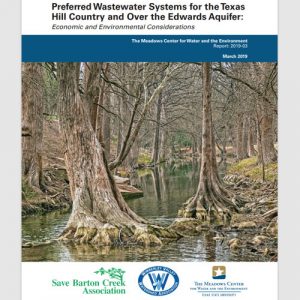Preferred Wastewater Systems for the Texas Hill Country and Over the Edwards Aquifer: Economic and Environmental Considerations

The Texas Hill Country is blessed with incredible charm and aesthetic appeal; Its natural environment including creeks, rivers, and springs are a central draw. Many Hill Country residents rely on wells for their drinking water and livelihoods. Creeks and springs serve as important recreational hubs, and help sustain wildlife and livestock. Water in the Hill Country is also a precious limited resource. This report helps us begin to understand how we can protect Hill Country waterways while also meeting the wastewater service challenges of our region.
In the Hill Country, there is a need for approaches to development that serve well on multiple fronts– that prevent wastewater effluent pollutants from impacting local streams, that consider the water limitations of our drought-prone region, and provide affordable and reliable wastewater systems. Planning for wastewater service in a development can also be considered with other water needs such as the need for non-potable water within and outside buildings, and stormwater planning. This holistic approach to planning water within a development, called One Water, is gaining momentum nationally and in our region.
This report is not a comprehensive guide for how to design the ideal wastewater system for any given development. Instead, its purpose is to familiarize developers, property owners, city planners, and policymakers with modern, cost-effective wastewater solutions that can meet the unique service needs and conditions of the Hill Country. Most people are unfamiliar with wastewater systems other than conventional sewer infrastructure in urban settings. Likewise, much of the public has an impression that septic systems installed under current rules are akin to those relied on in decades past, built under much lower standards than exist today. Built properly, several scales of wastewater systems can meet the needs of our region, including the often unconsidered clustered/neighborhood systems that are between a large packaged plant and an individual onsite (septic) system.
Given the water limitations in the Hill Country, it’s a no-brainer to reuse wastewater effluent. This report illustrates how decentralized reuse can be the best option, depending on development patterns. This report does not offer a singular prescription to the challenges faced, but rather, presents new options that many developers and policy-makers may not have considered. We hope that making this information more easily available will encourage thinking beyond the status quo and move us to consider non-discharge wastewater approaches that are best for our communities and environment.